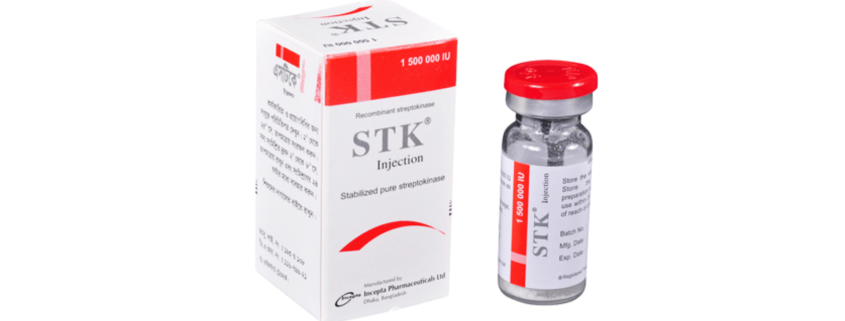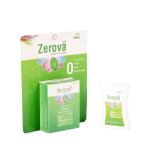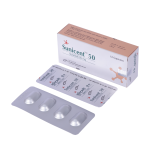STK Injection(Streptokinase)
![STK Injection(Streptokinase)]](https://dhakarx.com/wp-content/uploads/2024/05/STK-InjectionStreptokinase-p.png)
Therapeutic Group: Bio Tech
Presentation
STK Injection: Each vial contains 1 500 000 IU stabilized pure Streptokinase as lyophilized powder.
Description
Streptokinase is highly purified Streptokinase obtained from the culture filtrate of beta-haemolytic Streptococci of group C. Streptokinase acts with plasminogen to produce an ‘activator complex’ that converts plasminogen to the proteolytic enzyme, plasmin. The more plasminogen bound within this complex, the less plasminogen is left to be converted into its enzymatically active form. Therefore, high doses of Streptokinase are associated with a lower bleeding risk and low doses of Streptokinase are associated with a higher bleeding risk.
Indications
– Acute Evolving Myocardial Infarction
– Acute Massive Pulmonary Embolism
– Deep Vein Thrombosis
– Arterial Thrombosis or Embolism
– Arteriovenous Cannulae Occlusion
Dosage & Administration
Streptokinase can be reconstituted using 5 ml sodium chloride injection, USP or 5% Dextrose Injection, USP, directing the diluent at the side of the vacuum packed vial rather than into drug powder
Acute Myocardial Infarction
• IV infusion
o Vial size (IU): 15,00,000
o Total solution volume 45 ml
o Infusion rate: Infuse 45 ml within 60 mins
• Intracoronary infusion
o Vial size (IU): 2,50,000
o Total solution volume 125 ml
-20,000 IU bolus, Infusion rate: Loading dose of 10 ml
-2,000 IU/min. for 60 minutes, Infusion rate: 60 ml/hour
Pulmonary Embolism, Deep Vein Thrombosis, Arterial Thrombosis or Embolism
• 2,50,000 IU loading dose over 30 min, Vial size (IU): 15,00,000, Total solution volume 90 ml, Infusion rate: Infuse 30 ml/hour for 30 min
• 1,00,000 IU/hour for maintenance dose, Infusion rate: Infuse 6 ml/hour
Dosage Scheme
Reconstitution and Dilution:
The protein nature and lyophilized form of Streptokinase, require careful reconstitution and dilution. The following reconstitution and dilution procedures are recommended for vials & infusion bottles:
1. Slowly add 5 mL Sodium Chloride Injection, USP or 5% Dextrose Injection, USP to the Streptokinase vial directing the diluent at the side of the vacuum-packed vial rather than into the drug powder.
2. Roll and tilt the vial gently to reconstitute. Avoid shaking. (Shaking may cause foaming.) (If necessary, total volume may be increased to a maximum of 50 mL in plastic containers and the infusion pump rate should be adjusted. To facilitate setting the infusion pump rate, a total volume of 45 mL, or a multiple thereof, is recommended.
3. Withdraw the entire reconstituted contents of the vial; slowly and carefully dilute further to a total volume as recommended. Avoid shaking and agitation on dilution.
4. When diluting the 1 500 000 IU infusion bottle (50 mL), slowly add 5 mL Sodium Chloride Injection, USP, or 5% Dextrose Injection, USP, directing it at the side of the bottle rather than into the drug powder. Roll and tilt the bottle gently to reconstitute. Avoid shaking as it may cause foaming. Add an additional 40 mL of diluent to the bottle, avoiding shaking and agitation. (Total volume = 45 mL). Now administer by infusion pump.
5. Parenteral drug products should be inspected visually for particulate matter and discoloration prior to administration. (Human albumin may impart a slightly yellow color to the solution)
6. As Streptokinase contains no preservatives, it should be reconstituted immediately before use. The solution may be used for direct intravenous administration within eight hours following reconstitution if stored at 2-8 °C (36-46 °F).
7. Do not add other medication to the container of Streptokinase.
8. Unused reconstituted drug should be discarded.
Pediatric use: Safety & effectiveness in children have not been established.
Side Effects
The following adverse reactions are based on experience from clinical trials and on post marketing experience of Streptokinase.
General disorders
Common: Headache and back pain, muscle pain (including myalgia), chills and/or fever as well as asthenia/malaise.
Haemorrhage and bleeding
Common: Haemorrhages at invaded or disturbed sites, including the injection site, and ecchymoses. Gastrointestinal or genitourinary bleedings (including aggravation of menstrual bleeding), epistaxis.
Uncommon: Intracranial haemorrhages with their complications and possible fatal outcome, retinal haemorrhages, severe haemorrhages (also with fatal outcome) including liver haemorrhages, retroperitoneal bleedings, splenic rupture. Blood transfusions are rarely required.
Immune system disorders
Very common: Development of antistreptokinase antibodies
Common: Allergic-anaphylactic reactions such as rash, flushing, itching, urticaria, angioneurotic oedema, minor breathing difficulty, periorbital swelling, bronchospasm or hypotension.
Nervous system disorders
Rare: Neurologic symptoms (e.g., dizziness, confusion, paralysis, hemiparesis, agitation or convulsion) in the context of cerebral haemorrhages or cardiovascular disorders with hypoperfusion of the brain.
Cardiac complication and vascular disorders
Very common: Hypotension, heart rate and rhythm disorders, angina pectoris.
Common: Recurrent ischaemia, heart failure, reinfarction, cardiogenic shock, pericarditis, pulmonary oedema.
Uncommon: Cardiac arrest (leading to respiratory arrest), mitral insufficiency, pericardial effusion, cardiac tamponade, myocardial rupture, pulmonary or distal embolism.
Respiratory disorders
Very rare: Non-cardiogenic pulmonary oedema after intracoronary thrombolytic therapy in patients with extensive myocardial infarction.
Gastrointestinal disorders
Common: Nausea, diarrhoea, epigastric pain and vomiting.
Precautions
Because of the increased likelihood of resistance, due to antistreptokinase antibodies, retreatment with Streptokinase or Streptokinase-containing products may not be effective if administered between five days and twelve months of prior Streptokinase administration or Streptococcal infections, such as Streptococcal pharyngitis, acute rheumatic fever or acute glomerulonephritis secondary to a Streptococcal infection.
In principle, no thrombolytic treatment should be commenced before the 10th postoperative day. However, in cases of pulmonary embolism, the indication for earlier treatment may be very strong and after careful consideration of all the risks, Streptokinase may be given before the tenth postoperative day. The danger of bleeding from the operative area must, of course, be taken into account.
The danger of haemorrhage is increased by simultaneous or previous treatment with anticoagulants (e.g., Heparin) or substances which inhibit platelet formation or function. If the patient is under active heparinisation, it should be neutralised by the administration of protamine sulphate before the start of thrombolytic therapy.
Repeated Administration
After administration of Streptokinase, the titre of antistreptokinase antibodies begins to rise after approximately one week, reaching a peak at 2 to 3 weeks and remains elevated for 8 to 12 months. Because of the increased likelihood of resistance, Streptokinase may not be effective if given during this period.
Use in Pregnancy & Lactation
Pregnancy category C. It is not known whether Streptokinase is excreted in the breast milk, nor whether it has harmful effects on the newborn. In the absence of further information, it is recommended that breast-feeding be discontinued in women who are to receive Streptokinase.
Drug Interaction
There is an increased risk of haemorrhage in patients simultaneously or previously receiving anticoagulants (such as Heparin or Coumarin derivatives) or drugs which inhibit platelet formation or function (e.g., Platelet aggregation inhibitors, Dextrans, Phenylbutazone, Dipyridamole, Non-steroidal anti-inflammatory drugs). The effect of Heparin can be neutralized rapidly by administration of Protamine Sulphate. The Thrombin time (TT) should not be more than twice the normal control value before thrombolytic therapy is started. In the case of prior treatment with coumarin derivatives, the International Normalized Ratio (INR) must be less than 1.3 before starting Streptokinase infusion.
Combination of Streptokinase with Aspirin for treatment of Myocardial infarction
Study showed a significant benefit to patients treated with these two agents after acute myocardial infarction. Mortality (both short and longer term) was reduced in these patients to a greater extent than in those treated with either agent alone.
Unless contraindicated, the concomitant use of Acetylsalicylic acid (ASA, Aspirin), starting prior to Streptokinase infusion and continued for one month thereafter may be instituted at the discretion of the physician. The benefit of combination therapy should therefore be weighed against the risk of increased haemorrhage.
Anticoagulation treatment following Streptokinase
Following high dose (1.5 million IU), short term treatment with Streptokinase, for acute myocardial infarction, the use of subsequent anticoagulant treatment has not yet been shown to be of unequivocal benefit. Therefore, in this situation, the use of anticoagulants should be decided by the physician.
Over Dose
If uncontrollable bleeding occurs as a result of overdosage, Streptokinase infusion should be ceased immediately. Bleeding can be reversed and blood loss managed effectively with appropriate replacement therapy. Administration of aminocaproic acid or aprotinin may be useful.
Storage
Streptokinase vial should be stored at 2 to 25 °C. Once reconstituted with physiological saline, the physico-chemical stability has been demonstrated for 24 hours at 2 to 8 °C. From a microbiological point of view and as Streptokinase 1 500 000 contains no preservative, the reconstituted product should be used immediately. If it is not administered immediately, storage shall not exceed 24 hours at 2 to 8 °C. Keep out of the reach of children.
Commercial Pack
STK Injection: Each box contains 1 vial of 1 500 000 IU stabilized pure Streptokinase as lyophilized powder.



